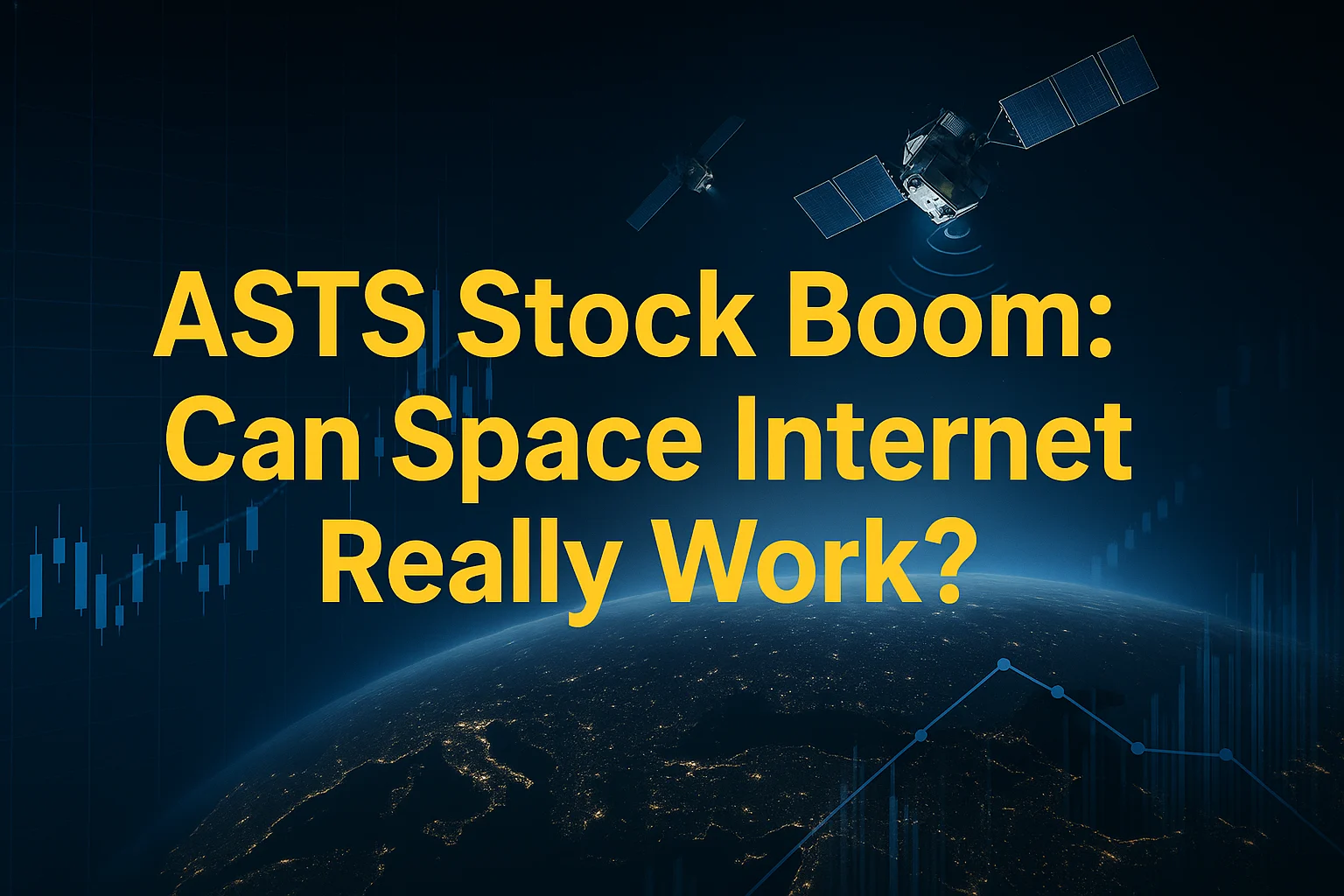ASTS stock has investors excited for 2025. The company, ASTSpaceMobile, aims to bring mobile internet to every corner of the planet. This “space-based internet” model differs from traditional satellite internet: its BlueBird satellites transmit 4G/5G signals directly to ordinary smartphones, without the need for an additional dish or terminal. Agreements with Verizon and AT&T in the US, partnerships in India, Africa, and other regions, and a rapidly rising share price have generated excitement in the market. But will this business be sustainable in the long run?
🌌 ASTS Stock Highlights 2025

🚀 Growing Investor Excitement
ASTS stock is capturing investor attention for 2025.
📡 Global Internet Vision
ASTSpaceMobile aims to deliver mobile internet to every corner of the world.
🛰️ Unique Technology
BlueBird satellites send 4G/5G signals directly to smartphones — no dish or terminal required.
🤝 Major Partnerships
Agreements with Verizon, AT&T (US), and tie-ups across India & Africa.
💹 Market Buzz
Rising share prices and high expectations fuel market excitement.
❓ Future Question
Can this space-based internet model remain sustainable long-term?
Unique model of AST SpaceMobile
The company is using its hundreds of feet wide BlueBird satellites as “mobile towers in space.” These satellites orbit at an altitude of about 550 km above the ground and deliver 4G/5G network signals directly, so users only need their existing phones. This model aims to bring connectivity to the 3–5 billion people for whom installing towers is expensive or impractical. In 2023, an experimental satellite called BlueWalker 3 successfully performed calls and data transfers at speeds of about 21 Mbps – demonstrating that this technology actually works.
AST SpaceMobile’s business model is based on “super wholesale” – the company shares revenue with mobile network operators (MNOs), so customers will receive services from their local operator rather than directly from the company. Operators don’t have to install new infrastructure, so profits are expected to be higher.
🛰️ AST SpaceMobile Highlights

📡 Mobile Towers in Space
BlueBird satellites act as mobile towers orbiting at ~550 km, sending 4G/5G signals directly to regular phones.
🌍 Bridging Connectivity Gap
Designed to serve 3–5 billion people for whom building traditional towers is expensive or impractical.
🚀 BlueWalker 3 Proof
In 2023, BlueWalker 3 successfully performed calls & data transfers at ~21 Mbps, showing the tech works.
💼 Super Wholesale Model
AST SpaceMobile shares revenue with mobile operators, so customers use their local operator’s service while operators avoid new infrastructure.
📈 Higher Profit Potential
Since operators don’t invest in new towers, AST SpaceMobile expects higher profit margins.
Why the boom in shares?
ASTS stock was below two dollars in 2024, but it reached nearly $60 in 2025 – an increase of nearly 250%. There were several reasons for this surge:
- Verizon and AT&T Agreements: In September 2025, Verizon signed a contract to provide phone service directly from the company’s satellites using the 850 MHz band. This requires only 45–60 satellites, while Starlink will require thousands. AT&T is already a partner.
- Partnerships and Investments: Google invested $203 million, and Trinity Capital signed a $100 million financing agreement. The collaboration with Vodafone Idea to provide services in India is also a major step.
- Spectrum Availability: The company acquired L-band spectrum in June 2025, allowing it to independently provide speeds up to 120 Mbps.
- Satellite Progress: Five Block 1 satellites were launched in 2024 and Block 2 satellites in 2025. The company plans to launch one or two satellites per month to build a network of 45–60 satellites by the end of 2026.
- Earnings Projections: Revenue in Q1 2025 was just $0.72 million, and losses were $45.7 million, but the company has guided for revenue of $50–75 million for H2 2025. Investors believe revenue could grow rapidly.
📊 ASTS Stock Surge 2025 Highlights

🚀 Massive Stock Growth
ASTS stock rose from under $2 in 2024 to nearly $60 in 2025 — a surge of about 250%.
📡 Verizon & AT&T Agreements
In Sept 2025, Verizon signed a deal to deliver phone service via ASTS satellites using the 850 MHz band. AT&T is already an active partner.
💰 Partnerships & Investments
Google invested $203M, Trinity Capital added $100M financing, and a Vodafone Idea collaboration in India boosted global reach.
📶 Spectrum Expansion
In June 2025, ASTS acquired L-band spectrum, enabling independent 4G/5G speeds up to 120 Mbps.
🛰️ Satellite Progress
Five Block 1 satellites launched in 2024 and Block 2 in 2025. The company targets 45–60 satellites by end of 2026.
💹 Earnings Outlook
Despite Q1 2025 losses ($45.7M), ASTS projects H2 revenue of $50–75M — fueling investor optimism for rapid growth.
This positive news has been a key driver of the rally in ASTS stock. Several analysts have raised their price targets to a “Strong Buy” rating.
The allure of technology
The main attraction of ASTS stock is that the company can provide internet access to people around the world without expensive hardware. Starlink, EchoStar, or other satellite broadband providers typically require a dish and terminal, while AST only requires a smartphone.
This model can be extremely useful in dynamic markets such as rural areas, disaster-affected regions, or cruise ships. The company claims high margins due to its revenue-sharing model, with dividends exceeding 90%.
Challenges and risks
- Revenue still very low: In Q2 2025, the company reported revenue of $1.156 million, compared to analyst expectations of $6 million; the company reported a loss of $99.3 million. According to StocksToTrade, revenue per share was approximately $0.016, and net income was $135.9 million.
- Capital and cash burn: According to Scotiabank, heavy capital expenditures and high cash burn will cause the company to continue burning cash until at least 2027, which could lead to “painful corrections” for investors.
- Launch delays: Analysts say the delivery of BlueBird 2 satellites is six months late. If delays continue, Verizon or other operators may turn to Starlink.
- Competition: SpaceX’s Starlink Direct-to-Cell service plans to launch 15,000 new satellites and has purchased spectrum rights from EchoStar for $17 billion, allowing it to provide better service. Starlink has already launched service in some areas, while AST’s network won’t be fully ready until 2026. Another competitor, Lynk, has also launched text-messaging services.
- Stock Price Bubble: Bloomberg and investors warn that inflated prices could lead to a “valuation bubble”; some analysts have given ASTS stock a “Sell” rating due to extreme volatility.
- Legal and Regulatory Challenges: International spectrum, Federal Communications Commission (FCC) approvals, and licenses from foreign governments are all subject to time. Any major restrictions or regulatory hurdles could delay the plan.
⚠️ ASTS Risks & Challenges
💸 Low Revenue
Q2 2025 revenue was $1.156M vs $6M expected, with a $99.3M loss. Revenue per share ≈ $0.016; net income $135.9M.
🏦 Capital & Cash Burn
Heavy capital expenditures and high cash burn could continue until 2027, potentially causing painful corrections for investors.
🛰️ Launch Delays
BlueBird 2 satellite delivery is six months late. Further delays may push operators like Verizon toward competitors like Starlink.
⚔️ Competition
Starlink plans 15,000 new satellites with spectrum rights from EchoStar; service already launched in some areas. Lynk also offers text messaging services.
📈 Stock Price Bubble
Inflated prices may create a valuation bubble; some analysts rate ASTS stock as “Sell” due to extreme volatility.
⚖️ Legal & Regulatory Challenges
International spectrum, FCC approvals, and foreign government licenses may cause delays. Regulatory hurdles could slow down plans.
What next?
According to the company’s CEO, satellites will launch every one or two months in 2025-26, and a network of 45-60 satellites will be formed by the end of 2026. If completed on time, AST SpaceMobile will be able to provide continuous service in the US, Europe, and Japan. Analysts predict that if the planned projects are successful, earnings could grow rapidly and the value of ASTS stock could rise further.
However, investors need to be patient. High capital expenditures, long break-even times, and intense competition will make this a risky bet for the first few years. In the coming months, Q3 and Q4 results, launch schedules, and news on customer contracts will determine the direction of ASTS stock.
Conclusion:
“Space-based internet” sounds attractive, and AST SpaceMobile has even demonstrated technical evidence. The recent surge in ASTS stock is largely driven by optimism—collaborations with major companies like Verizon, AT&T, and Vodafone, a huge potential market, and technological advances. However, the financial reality is that the company remains heavily incurring losses, has a small number of satellites, and giants like Starlink are rapidly advancing.
The message for American investors and Hindi-speaking readers is that ASTS stock has potential, but the risks are significant. Long-term success can only be achieved if the company launches its satellites on time, overcomes regulatory challenges, and grows revenue by staying ahead of competitors. It will be interesting to see whether AST SpaceMobile can truly make every phone a “satellite phone” and whether ASTS stock’s current rally will prove sustainable.
Also read:
🔷 Markets fell on news of the US shutdown, but gold again performed well.
🔷 AppLovin Stock Tanks Despite Strong Year — Shocking Reason Revealed!
🔷 Big news for AI investors: OpenAI and AMD enter into a massive partnership












